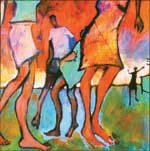Ellen Langford, now 37, used to be one of those people who thought getting out of Mississippi was the thing to do. She had spent 17 years growing up here, and it was time to go. She was an artist then, headed to Colby College in Maine to free herself and grow.
She didn't major in art at Colby, though. Her "feminist father" urged her to pursue religion instead, hoping to produce a female priest. After college, Langford found herself in numerous jobs in San Francisco—baking bread, waiting tables and teaching school.
Then she heard a voice—it was time to go back to Mississippi.
"I don't actually hear voices," she laughs. "But I sort of heard a voice that told me to go back to Mississippi for a year."
What she expected to be a relatively short trip became more permanent when she fell in love here a month before her expected departure. Now, after six years in Mississippi, Langford admits she's a different painter than she used to be. "My use of color is more cohesive," she explains. "And my sense of identity is stronger."
Color, more so than realistic form, dominates Langford's creations. She explains her style: "I don't seem to have been given the gift of the skills the photo-realists have to convincingly represent a scene such as that in accurate detail to the minutia. Instead, I've been given something that leads me blunderingly to respond and try to interpret and eventually let go and let a painting become something that takes us to that place but lets us have our own experience of it, completely individually."
Though Langford most identifies her style with the Bay Area figurative painters, her paintings are particularly Southern now. Colorful chickens and clotheslines dot her canvases. Beautiful female bodies lounge in rocking chairs on porches. Bicycles appear often, with cyclists riding down roads untouched by the big city in Langford's creations.
Each painting—often cleverly named with titles like "Hey Chickens" or "Do You Like My Hat?"—has the obvious Langford mark on it. From the other side of a gallery, you can spot her signature use of color—vibrant juxtaposition that could only arise after layers have been stacked on top of each other. What you can't see from the other side of any gallery, though, are the small strokes of colors that Langford sometimes sneaks into her paintings. On first glance, you might see a mix of bold blues and reds, but upon close inspection you'll find an appropriately placed spot of teal.
Though her use of color may seem carefully executed, Langford insists that many of her best color creations occur by accident. She explains, "In my most successful paintings, generally the color is not at all what I started out thinking and instead has insisted on becoming its own thing."
These accidents mimic nature, she adds. "Colors no one has planned appear and are so evocative of feelings most of us know but can't begin to express," she explains, citing examples: "a house with peeling paint, a rusted gate, overgrown shrubbery, the evening light hitting just right on a nearby pine making the bark appear impossibly purple."
Though Langford admits that she's mostly drawn to color and shapes, she also says that she's particularly interested in conveying narratives through her paintings. Hence the quirky titles.
"I like to be communicating with a painting, but I want the observer to have their own experience," she says. "I find that making a thoughtful title furthers the conversation between me and the observer."
Beginning Sept. 16, Jacksonians can engage in this metaphorical conversation when Langford's works go on display at Brown's Fine Art Gallery. A reception from 7-9 p.m. will allow for a more tangible conversation, as well.



Comments
Use the comment form below to begin a discussion about this content.
comments powered by Disqus